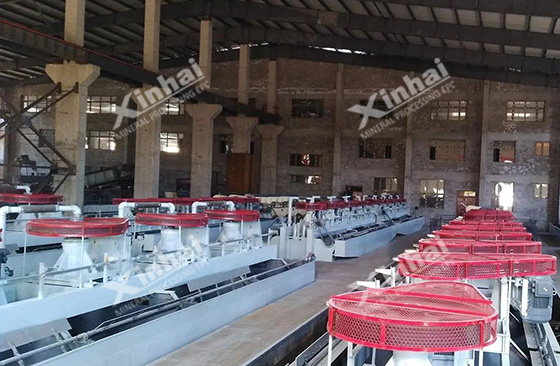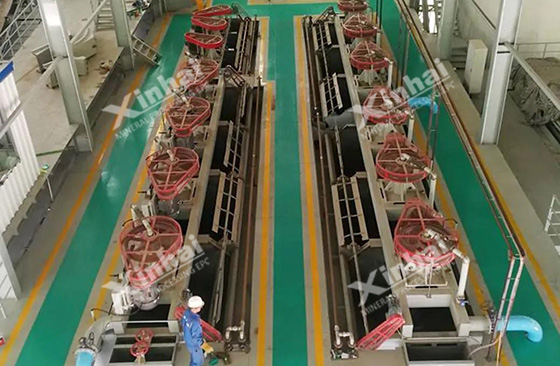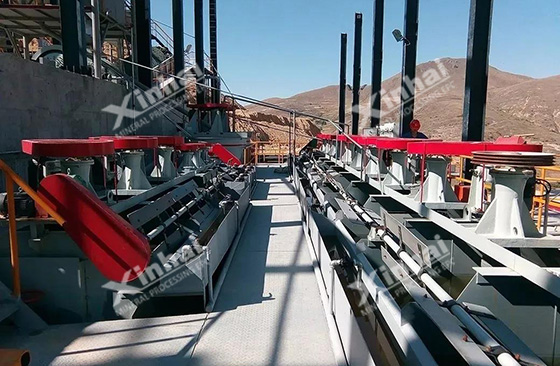
In general, common mineral impurities in silica sand such as feldspar, mica and other silicate minerals, more adopt flotation process for separation, in order to remove the majority of mineral particles outside quartz sand, and enrichment quartz. Due to the difference of water wettability of different mineral surfaces, hydrophobic particles tend to stick to bubbles and rise to the liquid level, while hydrophilic particles will escape from suspension or sink into the water after collision with bubbles, so as to achieve the purpose of mineral separation.
The flotation used in the silica sand processing can not only remove the mica, feldspar minerals, but also folate the phosphorus, iron and other minerals, and remove the broken and grinding mixed with secondary pig iron. Below, let's take you to understand in detail how to achieve the flotation separation of mica, feldspar, iron ore and apatite and silcia sand.

A large number of anions O2- and F- with extremely low zero electric point are dissociated from mica. After exposure to layered structure, the cationic collector can be used for recovery in a wide pH range (pH=2-13). The pH range of feldspar in the cationic harvesting system (pH=4-11) is smaller than mica, so mica can be preferred to separate under the strong acid conditions.

The feldspar and silica sand belong to frame silicate minerals. In addition to similar physical properties, chemical composition and structure, they also have the same charging mechanism in aqueous solution, low zero electric point. The main difference between feldspar and silica sand lies in the structure of feldspar. The alumino-oxygen tetrahedron replaces the silicon-oxygen tetrahedron, and introduces K+, Na+ and other alkali metal ions as the price compensation. The alkali metal ions are easy to dissociate in water, which makes the zero electric point of feldspar lower than that of silica sand, thus realizing the flotation separation.

At present, the flotation separation of feldspar and silica sand can be divided into acidic conditions of fluoride flotation, fluoride-free flotation and fluoride-free acid method according to the use of different reagents. The strong acidic medium will corrode the equipment to some extent, which brings a lot of inconvenience to the actual operation, so the fluorine-free acid-free method is usually adopted. This method can be divided into neutral pumice method and alkaline pumice method, which can be selected according to the actual situation.
The zero electric point of iron ore in silica sand impurity is mostly above 5, and it is suggested to use anion collector under the positive charge in an acidic environment. Such as:
The flotation reagents of oxidized iron ore are fatty acids (soaps), alkyl sulfonates or sulfates.
The flotation reagents of pyrite were yellow, with an amount of about 200ppMW.
The flotation reagents of ilmenite generally use sodium oleate (0.21mol/L), adjust the pulp pH value to 4-10. In addition, the hydrocarbyl phosphoric acid collectors developed in recent years have good selectivity and collecting performance for ilmenite.

The phosphate minerals in silica sand generally exist in the form of apatite. The surface dissolution of apatite in the flotation pulp will change the surface properties of minerals and the chemical environment of flotation pulp. In general, the silica sand is easily activated by Ca2+ under the alkaline conditions (pH > 10), so the dissolved Ca2+ in the apatite solution will have an adverse effect on the separation of apatite and silica sand. Since the floatability of apatite is better than silica sand, Na2CO3 can be used as the pH regulator to improve the floatability of apatite, thus to increase the difference between the floatability of apatite and silica sand. Therefore, it is recommended to adopt Na2CO3 as the pH regulator and sodium silicate as the inhibitor for flotation separation of apatite and silica sand under the alkaline conditions.

In addition, the flotation separation of apatite minerals and silica sand can also be carried out by fatty acid soap anion collector, such as sodium oleate, oxidized paraffin soap, tar oil, etc. It should be noted that the fatty acid flotation apatite will be affected by water quality and temperature and other factors. Generally, add the aggravate oil, kerosene and other mineral oils to enhance the hydrophobic surface, so as to achieve the role of co-capture. The results show that the mixed collector is more effective than the single collector, which is beneficial to increase the recovery of silica sand.
In the actual beneficiation process, the selection of silica sand processing technology is usually determined by the properties of silica sand ore, plant conditions, investment budget and other factors. It is suggested to understand the silica sand first, then select the suitable silica sand processing technology through the ore beneficiation test report, thus to obtain the ideal technical and economic benefits.
To find out more about our products and solutions, please fill out the form below and one of our experts will get back to you shortly.